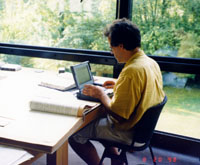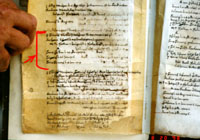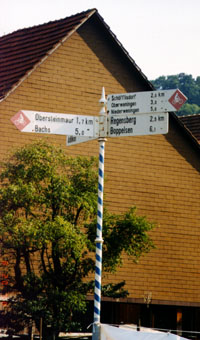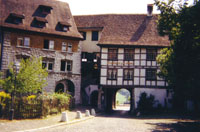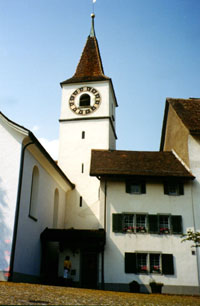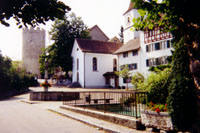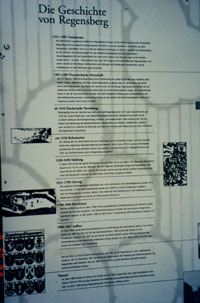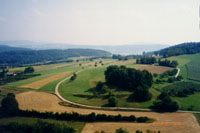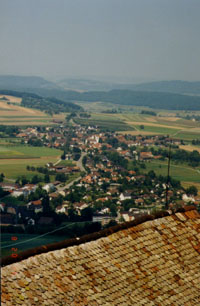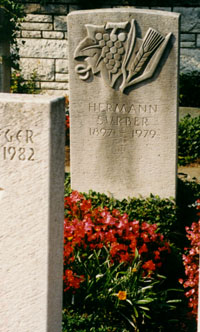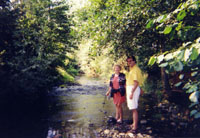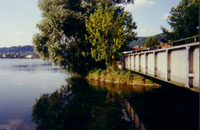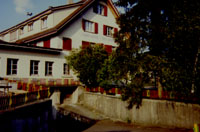Elvira Surber, Carol Surber
Lewis, Ulrich Surber, Jack Lewis
Manuel
Aicher at work on his laptop at the Staats Archiv.
The Steinmaur church "census"
records for 1724-1763. Heinrich Surber (Old Henry) is on the second page.
A significant Surber
crossroads, with familiar village names.
The gate into
Regensberg.
The Regensberg church.
Regensberg street with
castle tower in background.
This historical sign
stands just outside the castle tower.
Surber is the last name
and crest on the sign.
The beautiful Swiss
countryside around Regensberg.
View of Steinmaur and
Obersteinmaur from the castle tower.
Grave of Hermann Surber
in Schofflisdorf cemetery.
Manuel and I wading in
the Surb River near Niederweningen.
The confluence of the
Surb and the Aare Rivers.
This house has
"Alwin Surber" painted on its side.
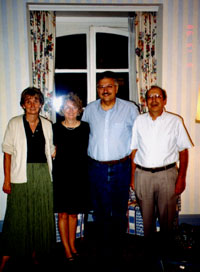
Jack and I arrived in Zurich by train in the early afternoon of August 19 and got settled in the Hotel Florhof, a charming building that dates to the 1500s. That night Ulrich Surber and his wife Elvira met us there (all arranged by email before we left home) and we went to dinner together at a lovely old mountaintop restaurant. We could see the entire city and its lights spread out below. Ulrich pointed out the vicinity of Regensberg, the gateway to "Surberland." Ulrich and Elvira are very friendly and charming and we enjoyed our time with them a great deal. Ulrich is head of the software development department for the city of Zurich. He brought me some great detailed maps of the Surb Valley area. He didn’t have too much more information to impart on the Surbers, other than the info he’s already provided through email to our Surber list, but he was very interested in our visit the next day. It was great to meet a REAL Swiss Surber!
Next morning, we were to meet with Manuel Aicher, the genealogical researcher who agreed to be our "tour guide" to the Surb River area. After a short period of confusion over which archives is which (the Staats Archiv is the archive for the canton (state) of Zurich; the Stadt Archiv is the archive for the city of Zurich. We were supposed to meet at the "Staat" but initially went to the "Stadt"!), we finally met up with Manuel. He had already pulled documents relating to our ancestor Old Henry from Steinmaur church records. It was a thrill seeing the handwritten records from 1724, recording Heinrich Surber and Barbara Schmid. Heinrich is on the second page of the bound volume containing the Steinmaur church "census" records for 1724-1763. Hans Heinrich (Young Henry) is listed as the 3rd child, born in 1719. It’s really amazing what detailed records these communities kept back then. Manuel said we’re lucky; not every community was so thorough.
Manuel worked on the research for several hours, typing directly from the handwritten records into his laptop database. (I brought a draft of his report home with me, and am still awaiting the final version from him. It’s a very detailed and thoroughly referenced tracing of ancestry from Young Henry back to Michael Surber, including information on the female lines that I haven’t seen before.) One other interesting thing that I got from Manuel is a copy of an essay published in 1985 (in German) documenting the immigration from the Zurich area to America in 1734/35, including Old Henry’s family. I am going to have it translated, but Manuel told us that Old Henry was part of an effort by a Swiss minister named Gotschi to start a Swiss colony or community in America. The effort ultimately failed, but he was instrumental in helping many families immigrate from the Zurich area. This essay, by a very well-known and highly regarded genealogist (Hans Ulrich Pfister) states positively that Henry boarded the ship with his second wife Anna Hinnen, who died enroute, and three children. His son Hans Kaspar also died during the voyage. Henry, his daughter Verena, and his son Hans Heinrich made it to America. Once I get this translated, I will make it available to the group, as well as the final version of the genealogical report.
I also gave Manuel a copy of Sheree Puccio’s Sorber/Surber report and we spent some time going over the areas of needed research, as I had discussed with Sheree before leaving on the trip. Manuel wants to deal directly with Sheree on this; he said that he would most likely be able to get to it by the end of September.
We went to lunch, and then to take our drive to the Regensberg/Surb Valley area, only about a half hour drive from downtown Zurich. Our first glimpse of the medieval hilltop town of Regensberg is from the village of Dielsdorf, which lies at the foot of the steep hill crowned by Regensberg. As we drive up the hill, we are charmed by the postcard view all around. We park and enter the walled town through a gate, instantly feeling transported back in time! Cobbled streets, 16th century houses immaculately kept, flowers everywhere. The town is dominated by the 13th century stone castle tower and the church steeple. The castle is now a children’s home but the tower is open to visitors. Just outside the tower is a large modern aluminum sign that outlines the history of Regensberg from its founding in 1241 to present. As Manuel painfully translates the German for us, I spot a grouping of family names and crests off to one side. Surber is the last family name in the group! These are the families that came under the protection of Regensberg, which in its heyday was a major population and trade center. I’ve never seen this crest before, which has a heart-shaped key, we think (instead of the fire-breathing dragon that I’ve seen presented as the Surber crest). Manuel seems to think that a family can have many different crests. More research needed…. At any rate, it was very exciting to see our name displayed on such an official and important-looking sign!
It costs 1 Swiss franc to climb the tower (we have a shortage of 1-SF coins and I blow one coin by pushing the bar the wrong way, so Jack and I have to squeeze through on one coin--oof!). From the top of the tower, you get a beautiful 360-degree view of the surrounding countryside. Manuel pointed out all the villages that figure so heavily in our Surber history: Steinmaur, Obersteinmaur, Niederweningen, Oberweningen, Schofflisdorf. Jack and I are amazed to see how similar it looks to our Botetourt County, Virginia. One thing I had been interested to see was whether the Swiss immigrants who settled in our area of Virginia were looking for a place that reminded them of home. Well, it sure seems like it! We stayed up on the tower for a long time. It was a beautiful sunny day and the sound of cowbells wafted up on the breeze. Sigh!! It was just about perfect, looking out at the landscape and villages that our ancestors called home.
Finally we came down and reluctantly left Regensberg. We drove to Steinmaur to see the village and the church and cemetery, to look for Surber graves. However, it turns out that in Switzerland graves are only maintained for about 20 to 30 years. Then they are dug up and someone else is buried in that grave! This is apparently a consequence of being such a small country, with so much land that is not tillable. The graves are beautifully kept though, each with a distinctive headstone and planted completely like a flower garden. We didn’t spot any Surber graves in the Steinmaur cemetery, but we did find some in Schofflisdorf. (These villages are within walking distance of each other.)
We then drove along the Surb River toward its confluence with the Aare, encountering each of the villages named above in turn. They are all reasonably close to each other. All are small and charming, dominated by the church, with its ever-present clock tower/steeple and little cemetery with immaculate, flower-covered graves. Just outside Niederweningen we spotted a pretty two-story white house with "ALWIN SURBER" written in large block letters on the side. Manuel didn’t know why the name was written there. We didn’t see any other houses like that. We also passed the Surbtal (Surb Valley) Garden Center and took a photo.
After touring the villages, we looked for a convenient access point to dip our toes in the Surb River. The fearless Manuel forged a trail through some brush and we reached the water’s edge. The water is lovely, clear and cool. The stream is about 10 or 12 feet across at this point. We gather some stones for mementoes, and also fill a water bottle to bring home. Jack spots three fairly large fish resting in a deep hole under a small bridge—bass, he thinks. Again, it reminds us of our own Craig Creek in Botetourt County, Virginia.
We continued our drive to the confluence of the Surb and the Aare River. The Surb gets wider and deeper; it’s about 30 feet across just before it joins the Aare (which is a very big river, a major tributary of the Rhine).
As the sun goes down, Manuel takes us back to our charming little hotel in Dielsdorf. The hotels in Switzerland are great. Friendly, helpful staff, impeccably clean. The only thing that we had a hard time getting used to was the way they make up their beds. All the double beds are like twin beds pushed together, made up with separate sheets. And no top sheet—just a down comforter to cover up with. But we dealt with it!
It was a perfect day and brought up all kinds of "warm and fuzzy" emotions—seeing the "homeland," back to my roots…it all came up for me. It was wonderful finally having a real image of the villages whose names have become so familiar through the Surber research, and having them be so beautiful. I want to go back!
